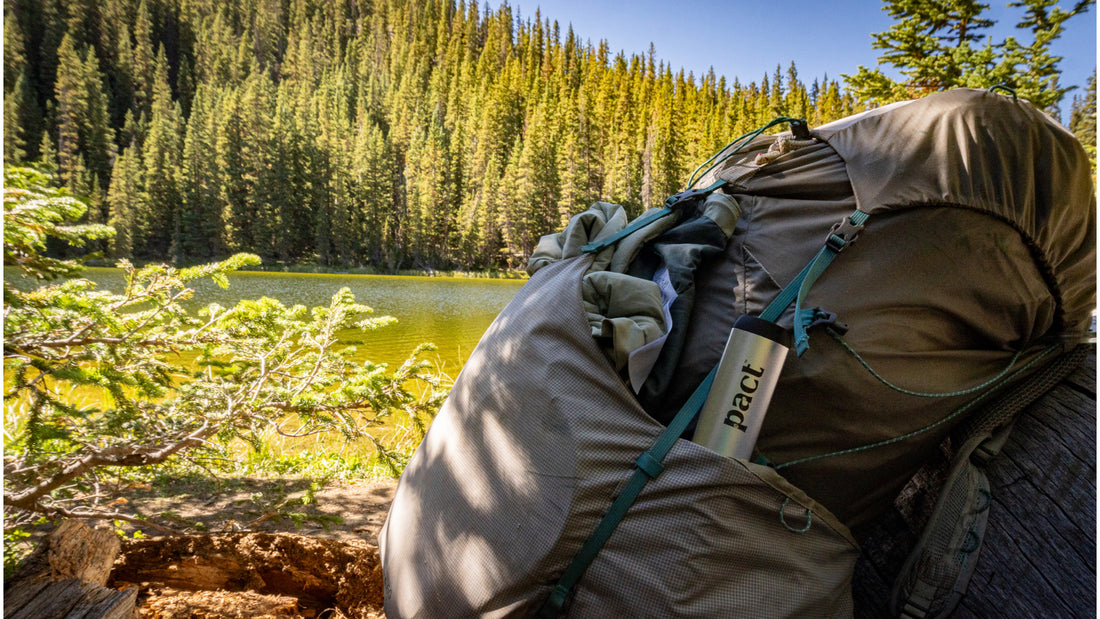Pooping in the outdoors whether you’re on a day hike, bike ride or multi-day backpacking trip is one of the most important and yet least discussed skills and practices.
Because it’s a taboo topic, we’re less likely to talk about it. This means outdoor enthusiasts, especially folks with less experience in the outdoors may find themselves unprepared when they have to ‘go’.
When human poop or used toilet paper is left on the surface of the ground, unburied or not packed out in places that require it, it creates a huge array of problems.
If you’re interested in learning about the far reaching effects of mis-handled poop in public lands you can read our post, The Growing Poop Problem In Our Public Lands to learn more. Otherwise, here’s the clif notes…
Why Human Poop Is Such A Problem
Mis-handled (unburied) poop and toilet paper is a huge burden for land managers to deal with. It takes time and human power that is already very limited. It is driving many popular areas to reduce access to public lands through stricter permitting systems, the removal of dispersed camping, timed entry systems and other measures. Many land managers describe issues with human waste as their number one resource issue.
Human poop has tons of harmful bacteria and viruses in it. It’s not like animals’ poop which is much more benign. As a result, pathogens from unburied poop in the backcountry can get into waterways, can harm wildlife, dogs and ultimately can be a major public health concern.
As a result, being prepared to poop in the woods in a way that follows Leave No Trace practices is essential for keeping our public lands open to the public, clean and free of disease. Here in Colorado, we’ve created Care for Colorado Principles in partnership with Leave No Trace to make these practices as clear as possible.
When To Bury & When To Pack Out Your Poop
The first question to ask yourself before any outing (including day trips) is: if I need to ‘go’ should I be prepared to bury or pack out my waste? First, always try to find a facility if you can. This could be a pit toilet or vault toilet which are often found at trailheads. Some areas also bring porta-potties. If that’s not possible, there are other simple solutions as long as you’re prepared ahead of time...
How To Bury Your Poop

Burying your poop is acceptable practice in most locations. To prepare for burying your waste, you need a shovel or trowel to dig your hole, some toilet tissue to wipe and something to sanitize your hands with after. According to Leave No Trace, here’s the steps for burying your poop:
- Find a private location that is at minimum 200’ or 75 adult paces from trails, waterways and campsites. This is key for ensuring that everyone’s poop isn’t buried in the same small areas and that bacteria from poop can’t contaminate waterways.
- Dig a hole 6-8” deep (sometimes called a “cat-hole”) using a small camp shovel or trowel.
- Poop in the hole while squatting over it. If you need a little help, try picking a spot near a log, rock or branch and use it for support. You got this!
- Wipe.
- Put your toilet paper in the hole or (for bonus points) pack it out in a ziploc bag. Toilet paper absolutely must be buried with your poop or packed out. Never leave it scattered on the surface of the ground. In desert environments it is best to pack out your toilet paper.
- Completely fill the hole with dirt afterwards and disguise the cat-hole using rocks, leaves or other natural materials.
- Sanitize hands to avoid spreading germs
Like most things, it can be pretty awkward at first, but you quickly get the hang of it. It’s also one of those things that when done well, can provide a surprising amount of satisfaction. Who knows, maybe you even found a spot with a great view. Most indoor bathrooms can’t offer that!
When To Pack Out Your Poop
Certain environments are especially fragile and aren’t well suited for decomposing poop in the ground. This is usually in places where the temperatures or the moisture in the soil are low. Poop must be packed out using a WAG Bag or Pack Out system (more on that in a second) in a few different kinds of environments, including:
- Arid Deserts: places like Moab, UT for example are very dry, as a result decomposition occurs very slowly if at all.
- Alpine Environments: the alpine is any elevation that trees do not grow due to the extended cold temperatures throughout the year. Much of the hiking in Colorado, like on Fourteeners or 14,000’ peaks for example occurs in the alpine also known as “above treeline”.
- When You Can’t Get Away: places where you can’t get the minimum 200’ from waterways, trails or campsites require that you pack out. A great example of this is the Grand Canyon where the canyon walls prevent users from getting far enough from the river to safely bury. In fact, rafting trips are a great example of a type of activity that requires packing out, using something called a groover.
- Ultra High Traffic Areas: some trails and backcountry destinations are so popular that Mother Nature can’t keep up with the volume of use and poop needs to be packed out. A great example in Colorado is Conundrum Hot Springs, a very popular backcountry hot spring. In this case, the Forest Service required the use of pack out bags.
How To Pack Out Your Poop
The conventional term for a pack out system is called a WAG Bag, which stands for Waste Alleviating Gel. Essentially this system is made up of two very thick sealable plastic bags. The inner bag is for pooping in. It contains a powder that de-ordorizes and dehydrates your poop inside the bag to make transporting it out less gross. The outer bag is for an added layer of protection to avoid any leakage. Most Wag Bags or pack out bags also come with some toilet paper, a wet wipe for cleaning your hands and simple instructions. Here’s the steps for using a WAG Bag or Pack Out Bag:
- Find a private spot away from trails, campgrounds and any other disturbances.
- Take out all the supplies and lay them on the ground so you know where everything is.
- Take the inner bag that contains the deodorizing powder in it, hold it open and poop into it. This can be made easier by leaning against a tree or rock to support you.
- Use the toilet paper to wipe and add the toilet paper to the inner bag.
- When finished, seal the inner bag by tying a knot in the top of the plastic opening. Some models have a ziploc style seal. Gently squeeze the air out of the inner bag prior to trying the knot as this can make transport a little easier. This must be done delicately and slowly.
- Place this inner bag in the outer bag and seal the outer bag.
- Sanitize your hands.
WAG Bags must be carried to the nearest trash receptacle, generally, in your backpack. Most users say that transporting it out to a place where you can dispose of it is the most uncomfortable part. To remedy this, consider bringing an extra trash bag to put the sealed bags in. This will provide added peace of mind.
Using a WAG Bag can be awkward at first, but you get the hang of it pretty quickly. WAG Bags cost about $3-$5 each and can be purchased at retailers like REI or on Amazon. They are great things to have in all your packs…just…in…case. Most of the time they’ll never get used, but everyone once in a while they are a lifesaver.
We’re Making Pooping In The Backcountry Easier
We started PACT Outdoors when we realized how big of a problem poop was becoming on public lands. It’s tempting to blame other, perhaps less experienced people for the problem. But, the more we investigated it, the more we realized people aren’t often the problem. It’s a lack of thoughtful tools and effective systems.

So, we created the world’s first all-in-one bathroom kit, the PACT Kit. Then, we created a lighter, more streamlined version called the PACT Lite Kit that holds a week's worth of bathroom supplies inside a small ergonomic shovel.

The main goal was to make it easier for people to be prepared by having a simple all-in-one kit you could throw in your pack. We have kits for everything we do outdoors from cooking to first-aid, and these kits make it easier to be prepared. So, why not have this for pooping, especially when the lack of preparedness has such significant consequences?
We’re Making Pooping In The Backcountry More Sustainable, Too
PACT Kits don’t come with toilet paper. Toilet paper contains numerous chemicals, including bleach, formaldehyde, and PFAS (also known as Forever Chemicals because they don’t break down). As a result, it’s not a great solution in the backcountry, especially if you’re burying it.

So we created PACT Wipes, dehydrated compressed Wipes that unfold into a thick, wet 9” towel with a squirt of water. Most people can get away with using 1-2 to clean up if you fold it between uses. PACT Wipes are free of the chemicals found in toilet paper and conventional wet wipes. They save weight and space in your pack, but leave you feeling nice and clean because of the added moisture.
PACT Kits also come with something called PACT Tabs. These are small wooden plugs inoculated with mycelium spores. What’s mycelium? It’s the root system for fungi. Mycelium branches out underground decomposing things. The species used in PACT Tabs breaks poop down faster and kills harmful bacteria found in poop like E. coli. You simply add three PACT Tabs to the cat-hole with your poop and PACT Wipe, then fill the hole with dirt as you normally would. Then, let nature do the rest.
The beauty of using the PACT System is that your poop decomposes faster with the mycelium in PACT Tabs. Plus, the Wipe is wet, and plant-based so it acts as food for the mycelium further speeding up decomposition. Faster decomposition and more environmentally-friendly materials means more pristine public lands, and more people that we can accommodate in the outdoors.
Planning Ahead
The most important thing to keep in mind with backcountry bathroom practice is to plan ahead. Keep a bathroom kit whether it’s a PACT Kit or a homemade kit with a ziploc bag, a trowel, toilet paper and sanitizer at the ready. Have a WAG Bag on hand and throw it in your pack just in case.

If you’re traveling somewhere new or for an extended period of time, do a quick search on the area to figure out what the preferred waste disposal practices are. Most National Parks and Forest Service sites provide clear instructions on the preferred methods be it burying or packing out.
If you’re heading out with others, ask if they have a bathroom kit or plan. Doing this helps to ensure others are prepared and it destigmatizes the topic.
It can seem weird and awkward at first, but once or twice and you'll get the hang of it, and you might even start to enjoy it :)

